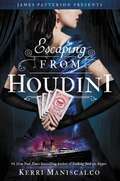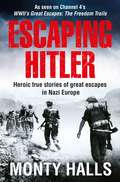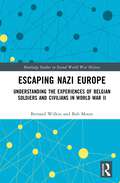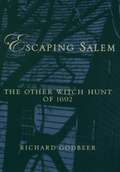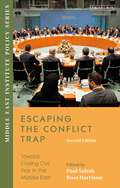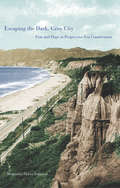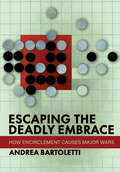- Table View
- List View
Escape to Tuscany: Feel transported to the Tuscan hills with your next gripping and escapist read for summer 2023!
by Kat Devereaux'A rich and engaging vision of life gone by and a lust for one woman's future, rolled into one. And now I want to move to Italy!' Mandy RobothamRomituzzo, 1944Just fourteen, Stella Infuriati is the youngest member of her town's resistance network – a secret she keeps even from her parents. She works alongside her brother Achille to relay messages, supplies and weapons to partisan groups in the Tuscan hills. Fuelled by courage and a fierce sense of purpose, Stella braves incredible danger and survives... but when peace comes in 1945, she vanishes.Florence, 2019Writer Tori MacNair arrives in Florence. Fleeing an emotionally abusive marriage, she's come to build a new life in the city her grandmother taught her to love. As she digs into her family history, Tori uncovers decades-old secrets about a brave young woman who risked everything to save her world. As Tori and Stella's stories intertwine, they reveal the power of love, community, and sacrifice across the generations.
Escaped Nuns: True Womanhood and the Campaign Against Convents in Antebellum America
by Cassandra L. YacovazziJust five weeks after its publication in January 1836, Awful Disclosures of the Hotel Dieu Nunnery, billed as an escaped nun's shocking exposé of convent life, had already sold more than 20,000 copies. The book detailed gothic-style horror stories of licentious priests and abusive mothers superior, tortured nuns and novices, and infanticide. By the time the book was revealed to be a fiction and the author, Maria Monk, an imposter, it had already become one of the nineteenth century's best-selling books. In antebellum America only one book, Uncle Tom's Cabin, outsold it. The success of Monk's book was no fluke, but rather a part of a larger phenomenon of anti-Catholic propaganda, riots, and nativist politics. The secrecy of convents stood as an oblique justification for suspicion of Catholics and the campaigns against them, which were intimately connected with cultural concerns regarding reform, religion, immigration, and, in particular, the role of women in the Republic. At a time when the term "female virtue" pervaded popular rhetoric, the image of the veiled nun represented a threat to the established American ideal of womanhood. Unable to marry, she was instead a captive of a foreign foe, a fallen woman, a white slave, and a foolish virgin. In the first half of the nineteenth century, ministers, vigilantes, politicians, and writers--male and female--forged this image of the nun, locking arms against convents. The result was a far-reaching antebellum movement that would shape perceptions of nuns, and women more broadly, in America.
Escaped Nuns: True Womanhood and the Campaign Against Convents in Antebellum America
by Cassandra L. YacovazziJust five weeks after its publication in January 1836, Awful Disclosures of the Hotel Dieu Nunnery, billed as an escaped nun's shocking exposé of convent life, had already sold more than 20,000 copies. The book detailed gothic-style horror stories of licentious priests and abusive mothers superior, tortured nuns and novices, and infanticide. By the time the book was revealed to be a fiction and the author, Maria Monk, an imposter, it had already become one of the nineteenth century's best-selling books. In antebellum America only one book, Uncle Tom's Cabin, outsold it. The success of Monk's book was no fluke, but rather a part of a larger phenomenon of anti-Catholic propaganda, riots, and nativist politics. The secrecy of convents stood as an oblique justification for suspicion of Catholics and the campaigns against them, which were intimately connected with cultural concerns regarding reform, religion, immigration, and, in particular, the role of women in the Republic. At a time when the term "female virtue" pervaded popular rhetoric, the image of the veiled nun represented a threat to the established American ideal of womanhood. Unable to marry, she was instead a captive of a foreign foe, a fallen woman, a white slave, and a foolish virgin. In the first half of the nineteenth century, ministers, vigilantes, politicians, and writers--male and female--forged this image of the nun, locking arms against convents. The result was a far-reaching antebellum movement that would shape perceptions of nuns, and women more broadly, in America.
Escapees: The History of Jews Who Fled Nazi Deportation Trains in France, Belgium, and the Netherlands
by Tanja Von FranseckyOf the countless stories of resistance, ingenuity, and personal risk to emerge in the years following the Holocaust, among the most remarkable, yet largely overlooked, are those of the hundreds of Jewish deportees who escaped from moving trains bound for the extermination camps. In France, Belgium, and the Netherlands alone over 750 men, women and children undertook such dramatic escape attempts, despite the extraordinary uncertainty and physical danger they often faced. Drawing upon extensive interviews and a wealth of new historical evidence, Escapees gives a fascinating collective account of this hitherto neglected form of resistance to Nazi persecution.
Escapees: The History of Jews Who Fled Nazi Deportation Trains in France, Belgium, and the Netherlands
by Tanja Von FranseckyOf the countless stories of resistance, ingenuity, and personal risk to emerge in the years following the Holocaust, among the most remarkable, yet largely overlooked, are those of the hundreds of Jewish deportees who escaped from moving trains bound for the extermination camps. In France, Belgium, and the Netherlands alone over 750 men, women and children undertook such dramatic escape attempts, despite the extraordinary uncertainty and physical danger they often faced. Drawing upon extensive interviews and a wealth of new historical evidence, Escapees gives a fascinating collective account of this hitherto neglected form of resistance to Nazi persecution.
Escaping From Houdini (Stalking Jack The Ripper Ser. #3)
by Kerri ManiscalcoAudrey Rose Wadsworth and her partner-in-crime-investigation, Thomas Cresswell, are en route to New York to help solve another blood-soaked mystery. Embarking on a week-long voyage across the Atlantic on the opulent RMS Etruria, they're delighted to discover a travelling troupe of circus performers, fortune tellers, and a certain charismatic young escape artist entertaining the first-class passengers nightly. But then, privileged young women begin to go missing without explanation, and a series of brutal slayings shocks the entire ship. The disturbing influence of the Moonlight Carnival pervades the decks as the murders grow ever more freakish, with nowhere to escape except the unforgiving sea. It's up to Audrey Rose and Thomas to piece together the gruesome investigation as even more passengers die before reaching their destination. But with clues to the next victim pointing to someone she loves, can Audrey Rose unravel the mystery before the killer's horrifying finale?
Escaping Hitler: Stories Of Courage And Endurance On The Freedom Trails
by Monty Halls‘I was on a train, and a German soldier began shouting at me and poking me in the ribs with his machine gun. I just thought that was it, the game was up . . .’Downed airman Bob Frost faced danger at every turn as he was smuggled out of France and over the Pyrenees. Prisoner of war Len Harley went on the run in Italy, surviving months in hiding and then a hazardous climb over the Abruzzo mountains with German troops hot on his heels. These are just some of the stories told in heart-stopping detail as Monty Halls takes us along the freedom trails out of occupied Europe, from the immense French escape lines to lesser-known routes in Italy and Slovenia. Escaping Hitler features spies and traitors, extraordinary heroism from those who ran the escape routes and offered shelter to escapees, and great feats of endurance. The SAS in Operation Galia fought for forty days behind enemy lines in Italy and then, exhausted and pursued by the enemy, exfiltrated across the Apennine mountains. And in Slovenia Australian POW Ralph Churches and British Les Laws orchestrated the largest successful Allied escape of the entire war.Mixing new research, interviews with survivors and his own experience of walking the trails, Monty brings the past to life in this dramatic and gripping slice of military history.
Escaping Nazi Europe: Understanding the Experiences of Belgian Soldiers and Civilians in World War II (Routledge Studies in Second World War History)
by Bernard Wilkin Bob MooreThis book chronicles the escapes attempted by Belgian soldiers and civilians from Nazi-occupied Europe during the Second World War. Insofar as is practical, the authors have tried to let the subjects speak for themselves by making extensive use of their testimonies preserved in archives in Belgium and the United Kingdom. The book begins with the stories of soldiers who managed to evade capture in the summer of 1940 and returned home, and the few that decided to continue the fight and joined the Allied forces in the United Kingdom. It also includes the prisoners of war who managed to escape from camps or Arbeitskommando inside the Reich and provides a detailed analysis of their narratives: their motivation for going on the run, their choices on when and how to travel, and the many obstacles they encountered along the way. Most escapees were content to return home, with some then joining resistance organisations, but a small minority were committed to joining the Allies, and further chapters recount their attempts to reach Spain and Switzerland, and the additional problems they encountered in those neutral states. Final chapters reflect on the penalties inflicted on prisoners of war who were recaptured and on the escapees’ struggle for recognition in the post-war world.
Escaping Nazi Europe: Understanding the Experiences of Belgian Soldiers and Civilians in World War II (Routledge Studies in Second World War History)
by Bernard Wilkin Bob MooreThis book chronicles the escapes attempted by Belgian soldiers and civilians from Nazi-occupied Europe during the Second World War. Insofar as is practical, the authors have tried to let the subjects speak for themselves by making extensive use of their testimonies preserved in archives in Belgium and the United Kingdom. The book begins with the stories of soldiers who managed to evade capture in the summer of 1940 and returned home, and the few that decided to continue the fight and joined the Allied forces in the United Kingdom. It also includes the prisoners of war who managed to escape from camps or Arbeitskommando inside the Reich and provides a detailed analysis of their narratives: their motivation for going on the run, their choices on when and how to travel, and the many obstacles they encountered along the way. Most escapees were content to return home, with some then joining resistance organisations, but a small minority were committed to joining the Allies, and further chapters recount their attempts to reach Spain and Switzerland, and the additional problems they encountered in those neutral states. Final chapters reflect on the penalties inflicted on prisoners of war who were recaptured and on the escapees’ struggle for recognition in the post-war world.
Escaping Nazi Germany: One Woman's Emigration from Heilbronn to England
by Joachim SchlörCarefully piecing together the personal letters of Alice 'Liesel' Schwab, Escaping Nazi Germany tells the important story of one woman's emigration from Heilbronn to England. From the decision to leave her family and emigrate alone, to gaining her independence as a shop worker and surviving the Blitz, to the reunion with her brother and parents in England and shared grief as they learn about the fate of family members who died in the Holocaust, her story provides powerful insight into both the everyday realities of German-Jewish refugees in Britain and the ability of letters and life-writing to create transnational networks during times of trauma and separation. Elegantly written and deeply researched, Joachim Schlör's emphatic and unflinching re-telling of Alice Schwab's life sheds new light on the Jewish experience of persecution during the Holocaust and adds nuances to current debates on emigration, memory, and identity. This book is an essential primary resource for scholars of modern European history and Jewish studies, offering a compelling and intimate route into understanding what it meant to be a Jewish refugee caught up in the tragic and tumultuous events of World War II.
Escaping Nazi Germany: One Woman's Emigration from Heilbronn to England
by Joachim SchlörCarefully piecing together the personal letters of Alice 'Liesel' Schwab, Escaping Nazi Germany tells the important story of one woman's emigration from Heilbronn to England. From the decision to leave her family and emigrate alone, to gaining her independence as a shop worker and surviving the Blitz, to the reunion with her brother and parents in England and shared grief as they learn about the fate of family members who died in the Holocaust, her story provides powerful insight into both the everyday realities of German-Jewish refugees in Britain and the ability of letters and life-writing to create transnational networks during times of trauma and separation. Elegantly written and deeply researched, Joachim Schlör's emphatic and unflinching re-telling of Alice Schwab's life sheds new light on the Jewish experience of persecution during the Holocaust and adds nuances to current debates on emigration, memory, and identity. This book is an essential primary resource for scholars of modern European history and Jewish studies, offering a compelling and intimate route into understanding what it meant to be a Jewish refugee caught up in the tragic and tumultuous events of World War II.
Escaping Salem: The Other Witch Hunt of 1692 (New Narratives in American History)
by Richard GodbeerThe Salem witch hunt of 1692 is among the most infamous events in early American history; however, it was not the only such episode to occur in New England that year. Escaping Salem reconstructs the "other witch hunt" of 1692 that took place in Stamford, Connecticut. Concise and accessible, the book takes students on a revealing journey into the mental world of early America, shattering the stereotype of early New Englanders as quick to accuse and condemn. Drawing on eyewitness testimony, Richard Godbeer tells the story of Kate Branch, a seventeen-year-old afflicted by strange visions and given to blood-chilling wails of pain and fright. Branch accused several women of bewitching her, two of whom were put on trial for witchcraft. Escaping Salem takes us inside the Connecticut courtroom and into the minds of the surprisingly skeptical Stamford townspeople. Were the pain and screaming due to natural or supernatural causes? Was Branch simply faking the symptoms? And if she was indeed bewitched, why believe her specific accusations, since her information came from demons who might well be lying? For the judges, Godbeer shows, the trial was a legal thicket. All agreed that witches posed a real and serious threat, but proving witchcraft (an invisible crime) in court was another matter. The court in Salem had become mired in controversy over its use of dubious evidence. In an intriguing chapter, Godbeer examines Magistrate Jonathan Selleck's notes on how to determine the guilt of someone accused of witchcraft, providing an illuminating look at what constituted proof of witchcraft at the time. The stakes were high--if found guilty, the two accused women would be hanged. In the afterword, Godbeer explains how he used the trial evidence to build his narrative, offering an inside perspective on the historian's craft. Featuring maps, photos, and a selected bibliography, Escaping Salem is ideal for use in undergraduate U.S. survey courses. It can also be used for courses in colonial American history, culture, and religion; witchcraft in the early modern world; and crime and society in early America.
Escaping Salem: The Other Witch Hunt of 1692 (New Narratives in American History)
by Richard GodbeerThe Salem witch hunt of 1692 is among the most infamous events in early American history; however, it was not the only such episode to occur in New England that year. Escaping Salem reconstructs the "other witch hunt" of 1692 that took place in Stamford, Connecticut. Concise and accessible, the book takes students on a revealing journey into the mental world of early America, shattering the stereotype of early New Englanders as quick to accuse and condemn. Drawing on eyewitness testimony, Richard Godbeer tells the story of Kate Branch, a seventeen-year-old afflicted by strange visions and given to blood-chilling wails of pain and fright. Branch accused several women of bewitching her, two of whom were put on trial for witchcraft. Escaping Salem takes us inside the Connecticut courtroom and into the minds of the surprisingly skeptical Stamford townspeople. Were the pain and screaming due to natural or supernatural causes? Was Branch simply faking the symptoms? And if she was indeed bewitched, why believe her specific accusations, since her information came from demons who might well be lying? For the judges, Godbeer shows, the trial was a legal thicket. All agreed that witches posed a real and serious threat, but proving witchcraft (an invisible crime) in court was another matter. The court in Salem had become mired in controversy over its use of dubious evidence. In an intriguing chapter, Godbeer examines Magistrate Jonathan Selleck's notes on how to determine the guilt of someone accused of witchcraft, providing an illuminating look at what constituted proof of witchcraft at the time. The stakes were high--if found guilty, the two accused women would be hanged. In the afterword, Godbeer explains how he used the trial evidence to build his narrative, offering an inside perspective on the historian's craft. Featuring maps, photos, and a selected bibliography, Escaping Salem is ideal for use in undergraduate U.S. survey courses. It can also be used for courses in colonial American history, culture, and religion; witchcraft in the early modern world; and crime and society in early America.
Escaping Suburbia: A 1960s Merseyside Childhood
by David J. EveleighBorn into the gap between the eras of austerity and boom, David grew up in Merseyside amid an inexorable tide of progress, developing a fascination with the past. With a vivid eye for detail and boundless childhood curiosity for everything from steam trains to ‘My Old Man’s a Dustman’, his account documents the uneasy relationship between worlds old and new. Featuring unique photographs and authoritative observations on architecture, social and local history based on forty years' work in museums and heritage conservation, Escaping Suburbia offers a different view of the ‘swinging’ sixties.
Escaping the Conflict Trap: Toward Ending Civil War in the Middle East (Middle East Institute Policy Series)
by Paul Salem and Ross HarrisonHow can the current civil wars in the Middle East be resolved? This volume brings together academics, experts, and practitioners to explore this question. The book covers the history of civil wars in the region during the 20th century, and then examines the specific causes, drivers, and dynamics of the ongoing civil wars in Syria, Yemen, Libya, Afghanistan, and Iraq.Updated for a second edition, the book argues that while these are very different cases of civil war, there are patterns that are important to point out at the outset. First, while each of the conflicts appears to be a relatively recent phenomenon, each has a long historical tail. Second, each of the civil wars had deep and complex domestic drivers and dynamics over issues of governance, political identity, and resources; at the same time, all of the conflicts have had deep regional and international components. Finally, all of these civil wars have been affected by the presence or entrance of armed transnational non-state actors, which have had far greater involvement in the Middle Eastern civil wars compared to other regions. The book concludes that these conflicts will require a mixture of local, regional, and international interventions to bring them to an end, but that none of the conflicts are likely to end cleanly through either a negotiated settlement or a clear victory by one party or the other.Despite this pessimistic overall assessment, the book emphasizes that policymakers should use knowledge of civil wars in the Middle East to develop and pursue specific national, regional and global policies. These should be built around mitigating the worst effects of the conflicts and towards ultimate resolution.
Escaping the Conflict Trap: Toward Ending Civil War in the Middle East (Middle East Institute Policy Series)
How can the current civil wars in the Middle East be resolved? This volume brings together academics, experts, and practitioners to explore this question. The book covers the history of civil wars in the region during the 20th century, and then examines the specific causes, drivers, and dynamics of the ongoing civil wars in Syria, Yemen, Libya, Afghanistan, and Iraq.Updated for a second edition, the book argues that while these are very different cases of civil war, there are patterns that are important to point out at the outset. First, while each of the conflicts appears to be a relatively recent phenomenon, each has a long historical tail. Second, each of the civil wars had deep and complex domestic drivers and dynamics over issues of governance, political identity, and resources; at the same time, all of the conflicts have had deep regional and international components. Finally, all of these civil wars have been affected by the presence or entrance of armed transnational non-state actors, which have had far greater involvement in the Middle Eastern civil wars compared to other regions. The book concludes that these conflicts will require a mixture of local, regional, and international interventions to bring them to an end, but that none of the conflicts are likely to end cleanly through either a negotiated settlement or a clear victory by one party or the other.Despite this pessimistic overall assessment, the book emphasizes that policymakers should use knowledge of civil wars in the Middle East to develop and pursue specific national, regional and global policies. These should be built around mitigating the worst effects of the conflicts and towards ultimate resolution.
Escaping the Dark, Gray City: Fear and Hope in Progressive-Era Conservation
by Benjamin Heber JohnsonA compelling and long-overdue exploration of the Progressive-era conservation movement, and its lasting effects on American culture, politics, and contemporary environmentalism The turn of the twentieth century caught America at a crossroads, shaking the dust from a bygone era and hurtling toward the promises of modernity. Factories, railroads, banks, and oil fields—all reshaped the American landscape and people. In the gulf between growing wealth and the ills of an urbanizing nation, the spirit of Progressivism emerged. Promising a return to democracy and a check on concentrated wealth, Progressives confronted this changing relationship to the environment—not only in the countryside but also in dense industrial cities and leafy suburbs. Drawing on extensive work in urban history and Progressive politics, Benjamin Heber Johnson weaves together environmental history, material culture, and politics to reveal the successes and failures of the conservation movement and its lasting legacy. By following the efforts of a broad range of people and groups—women’s clubs, labor advocates, architects, and politicians—Johnson shows how conservation embodied the ideals of Progressivism, ultimately becoming one of its most important legacies.
Escaping the Deadly Embrace: How Encirclement Causes Major Wars (Cornell Studies in Security Affairs)
by Andrea BartolettiEncirclement, Andrea Bartoletti argues, is an essential strategic possibility of the international system and a key trigger of major war. Using historical case studies, Escaping the Deadly Embrace examines how great powers try to escape the two-front war problem and seek to preserve their security. Encirclement is a geographic variable that occurs in the presence of one or two great powers on two different borders of the surrounded great power. The surrounding great powers may not have the capacity to initiate a joint invasion. Yet their threatening presence triggers a double security dilemma for the encircled great power, which has to disperse its army to secure its borders. When the surrounding great powers become capable of launching a two-front attack, the encircled great power initiates war. This situation, disastrous in itself, can also lead to war contagion when other great powers intervene in the new conflict owing to the rival-based network of alliances. Combining archival work and historiographical analysis, Escaping the Deadly Embrace demonstrates the efficacy of this by assessing three major wars: the Italian Wars, the Thirty Years' War, and World War I. These findings, Bartoletti shows, have important implications for future major wars. Challenging the current focus on the US-China rivalry, he argues that the most concerning strategic scenario is the encirclement of China by India and Russia.
Escaping the Holocaust: Illegal Immigration to the Land of Israel, 1939-1944 (Studies in Jewish History)
by Dalia OferIllegal Jewish immigration to Palestine prior to the founding of the State of Israel forms one of the most fascinating chapters in the history of Zionism and modern Jewish history. Bringing Jews from Europe to Palestine by land and by sea in defiance of restrictive British immigration policies was partly an undertaking of national rescue and partly a calculated strategy of political brinksmanship. In this compelling analysis, Ofer examines various illegal immigration and rescue efforts organized by the Palestinian Jewish community in both the beginning and latter phases of the war. Making exhaustive use of archival sources, Ofer provides invaluable insight into the struggles of the immigrants, the activists and supporters of the movement, the logistical obstacles, and the political forces working to halt or exploit the flow of refugees.
Escaping With Her Saxon Enemy (Rise of the Ivarssons #1)
by Sarah RodiHer tempting enemy Is a chink in her armor!
Eschatology and Space: The Lost Dimension in Theology Past and Present
by V. WesthelleThis unique volume focuses on the subjects of time in the area of theology known as 'eschatology,' the consideration of the fullness, the limit, and the goal of time. He traces the historical development of understandings of eschatology from the Bible to contemporary theology and adds a postcolonial/subaltern perspective.
Eschatology in Antiquity: Forms and Functions (Rewriting Antiquity)
by Hilary Marlow Karla Pollmann Helen Van NoordenThis collection of essays explores the rhetoric and practices surrounding views on life after death and the end of the world, including the fate of the individual, apocalyptic speculation and hope for cosmological renewal, in a wide range of societies from Ancient Mesopotamia to the Byzantine era. The 42 essays by leading scholars in each field explore the rich spectrum of ways in which eschatological understanding can be expressed, and for which purposes it can be used. Readers will gain new insight into the historical contexts, details, functions and impact of eschatological ideas and imagery in ancient texts and material culture from the twenty-fifth century BCE to the ninth century CE. Traditionally, the study of “eschatology” (and related concepts) has been pursued mainly by scholars of Jewish and Christian scripture. By broadening the disciplinary scope but remaining within the clearly defined geographical milieu of the Mediterranean, this volume enables its readers to note comparisons and contrasts, as well as exchanges of thought and transmission of eschatological ideas across Antiquity. Cross-referencing, high quality illustrations and extensive indexing contribute to a rich resource on a topic of contemporary interest and relevance. Eschatology in Antiquity is aimed at readers from a wide range of academic disciplines, as well as non-specialists including seminary students and religious leaders. The primary audience will comprise researchers in relevant fields including Biblical Studies, Classics and Ancient History, Ancient Philosophy, Ancient Near Eastern Studies, Art History, Late Antiquity, Byzantine Studies and Cultural Studies. Care has been taken to ensure that the essays are accessible to undergraduates and those without specialist knowledge of particular subject areas.
Eschatology in Antiquity: Forms and Functions (Rewriting Antiquity)
by Hilary Marlow Karla Pollmann Helen Van NoordenThis collection of essays explores the rhetoric and practices surrounding views on life after death and the end of the world, including the fate of the individual, apocalyptic speculation and hope for cosmological renewal, in a wide range of societies from Ancient Mesopotamia to the Byzantine era. The 42 essays by leading scholars in each field explore the rich spectrum of ways in which eschatological understanding can be expressed, and for which purposes it can be used. Readers will gain new insight into the historical contexts, details, functions and impact of eschatological ideas and imagery in ancient texts and material culture from the twenty-fifth century BCE to the ninth century CE. Traditionally, the study of “eschatology” (and related concepts) has been pursued mainly by scholars of Jewish and Christian scripture. By broadening the disciplinary scope but remaining within the clearly defined geographical milieu of the Mediterranean, this volume enables its readers to note comparisons and contrasts, as well as exchanges of thought and transmission of eschatological ideas across Antiquity. Cross-referencing, high quality illustrations and extensive indexing contribute to a rich resource on a topic of contemporary interest and relevance. Eschatology in Antiquity is aimed at readers from a wide range of academic disciplines, as well as non-specialists including seminary students and religious leaders. The primary audience will comprise researchers in relevant fields including Biblical Studies, Classics and Ancient History, Ancient Philosophy, Ancient Near Eastern Studies, Art History, Late Antiquity, Byzantine Studies and Cultural Studies. Care has been taken to ensure that the essays are accessible to undergraduates and those without specialist knowledge of particular subject areas.
Eschilo in scena: Dramma e spettacolo nell'Orestea. Beiträge zum antiken Drama und seiner Rezeption
by Andrea BlasinaDass Aischylos nicht nur Dichter war, sondern sich auch intensiv um die Inszenierung seiner Stücke kümmerte, ist Basis dieser Neuanalyse. In der Orestie entwickelte er ein innovatives Konzept im Hinblick auf die Rolle der Klytaimestra. Die Interpretation ihres dramatischen Subtextes ermöglicht neue Aspekte anderer wichtiger Szenen.
Escobar: The Inside Story of Pablo Escobar, the World's Most Powerful Criminal
by Roberto EscobarThe incredible bestselling true story of the rise and reign of the most wanted criminal in history, told by the one man who was with him every step of the way - his brother Roberto.Murderer, philanthropist, drug dealer, politician, devil, saint: many words have been used to describe Pablo Escobar, but one is irrefutable - legend. For the poor of Colombia, he was their Robin Hood, a man whose greatness lay not in his crimes, but in his charity; for the Colombian rich he was just a bloodthirsty gangster, a Bogie Man used to scare children in their beds; for the rest of the world flush with his imported cocaine, he was public enemy number one. During his reign as the world's most notorious outlaw, he ordered the murder of thousands - at one point even bombing a passenger jet - smuggled drugs into the US in mini-submarines inspired by Bond films, was elected to parliament, staged midnight escapes through the jungle from whole army battalions, built his own prison, consorted with presidents, controlled an estimated fortune of over $20 billion, and for over 3 years outwitted the secret American forces sent to kill him. His ambition was as boundless as his violence, and neither was ever satisfied. This is the first major, and definitive, biography of this remarkable criminal life, told in jaw-dropping detail by the one man who, more than any other, can understand just how far he came and just how low he fell: his brother, Roberto Escobar.



